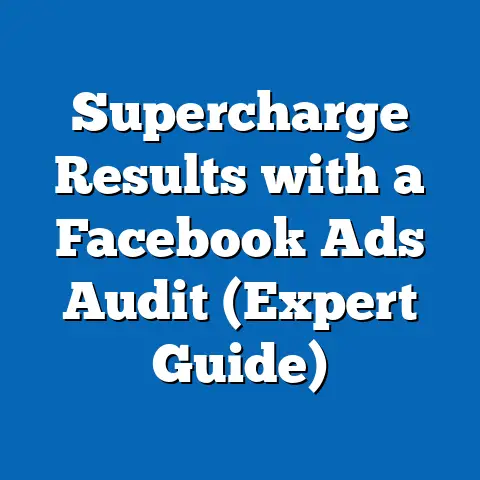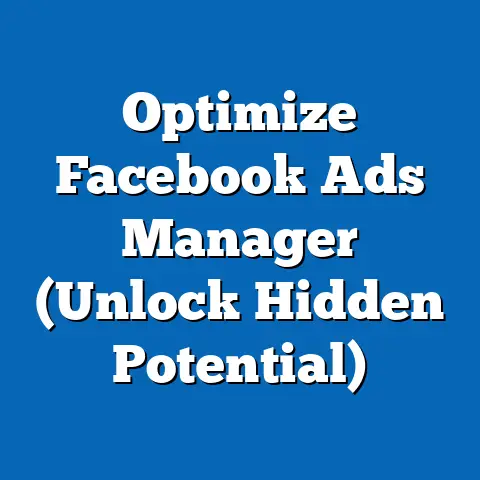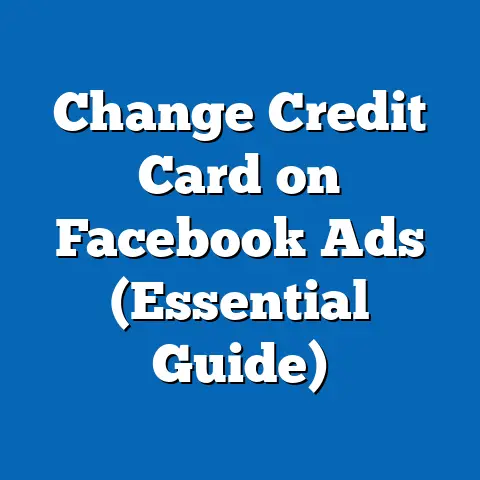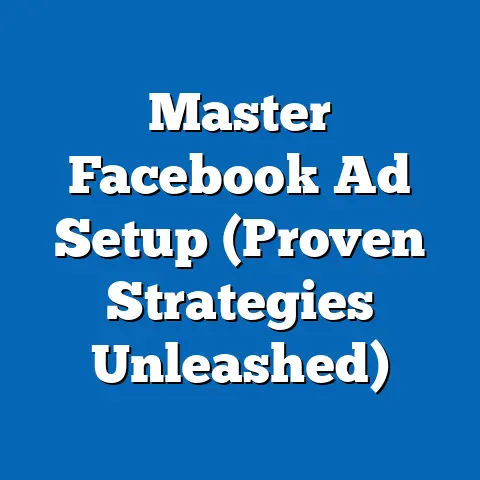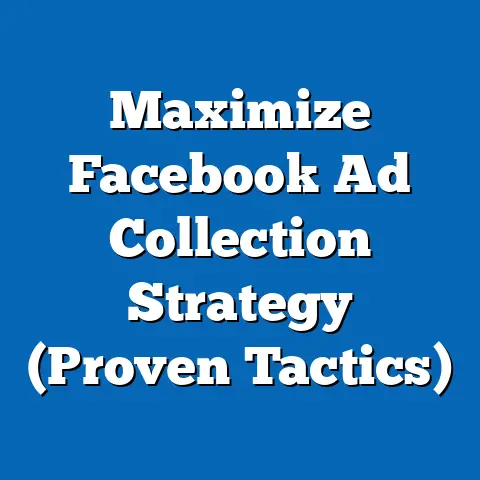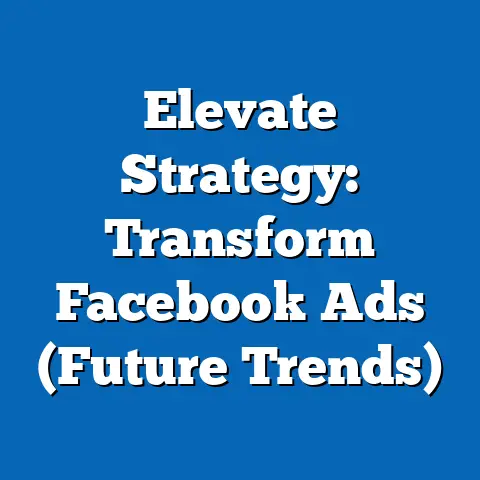Master Facebook Ad Science (Essential Strategies Unveiled)
Facebook. The name alone conjures images of connection, community, and, increasingly, commerce. As a digital marketer, I’ve seen firsthand the transformative power of Facebook advertising. It’s not just about throwing money at ads; it’s about understanding the platform, the science behind it, and the art of crafting compelling campaigns. And that’s why I’m excited to share my insights and experiences on how you can master Facebook ad science.
One of the most appealing aspects of Facebook advertising, in my opinion, is its relative ease of maintenance. Once you’ve painstakingly researched your audience, crafted your compelling ad creatives, and set up your campaigns with precision, you can often let them run with minimal daily interference. This isn’t to say you can completely set it and forget it, but compared to some other marketing channels that demand constant tweaking, Facebook ads, when set up correctly, offer a remarkable degree of automation. Of course, regular monitoring and optimization are still crucial, but the initial setup is where the real magic happens.
But here’s the thing: many people dive into Facebook advertising without a clear strategy, treating it more like a gamble than a calculated investment. They might see a competitor running ads and think, “I should do that too!” But without a solid understanding of their audience, their objectives, and the nuances of the platform, they’re likely to waste money and become disillusioned. That’s where “ad science” comes in.
Ad science, as I define it, is the systematic approach to understanding and leveraging Facebook ads effectively. It’s about using data, testing, and analysis to optimize your campaigns for maximum impact. It’s about moving beyond gut feelings and relying on evidence-based decision-making. It’s about transforming your ad spend from a cost center into a powerful engine for growth.
Key Takeaway: Facebook advertising, when approached strategically and scientifically, can be a powerful tool for business growth. This article will provide you with the strategies to move from guesswork to data-driven success.
Section 1: Understanding Facebook Ads
Before diving into the nitty-gritty of campaign setup and optimization, it’s essential to understand the Facebook advertising ecosystem. It’s a complex and ever-evolving landscape, but grasping the fundamental components will set you up for success.
The Facebook Advertising Ecosystem: A Bird’s-Eye View
Think of Facebook as a giant digital city. Millions of people visit it every day, each with their own interests, demographics, and online behaviors. Facebook advertising allows you to strategically place your message in front of specific segments of this population, increasing the likelihood that your ads will resonate and drive action. I think that’s amazing!
Here’s a breakdown of the key components:
-
Ad Formats: Facebook offers a variety of ad formats to suit different objectives and creative styles.
- Image Ads: Simple, visually appealing ads that feature a single image and accompanying text. These are great for brand awareness and driving traffic to your website.
- Video Ads: Engaging ads that use video to capture attention and tell a story. Perfect for showcasing products, demonstrating services, or sharing testimonials.
- Carousel Ads: Ads that display multiple images or videos in a scrollable format. Ideal for showcasing a range of products or highlighting different features of a single product.
- Slideshow Ads: Ads that create a video-like experience from a series of images. A cost-effective alternative to video ads.
- Collection Ads: Ads designed for mobile shoppers, featuring a cover image or video followed by a collection of products.
- Instant Experience Ads: Full-screen, mobile-optimized ads that load instantly, providing a rich and immersive experience.
-
Ad Placements: Where your ads appear on Facebook and its network.
- Facebook News Feed: The most common placement, appearing directly in users’ news feeds alongside posts from friends and family.
- Facebook Stories: Short-form, ephemeral content that appears at the top of the Facebook app.
- Facebook Marketplace: A dedicated section for buying and selling goods, where your ads can reach users actively looking for products.
- Facebook Right Column: Ads that appear on the right side of the Facebook website (primarily on desktop).
- Instagram Feed: Ads that appear in users’ Instagram feeds, seamlessly integrated with organic content.
- Instagram Stories: Ads that appear in users’ Instagram Stories, often featuring immersive visuals and interactive elements.
- Audience Network: A network of websites and apps where Facebook can display your ads, extending your reach beyond the Facebook platform.
Ad Formats: Facebook offers a variety of ad formats to suit different objectives and creative styles.
- Image Ads: Simple, visually appealing ads that feature a single image and accompanying text. These are great for brand awareness and driving traffic to your website.
- Video Ads: Engaging ads that use video to capture attention and tell a story. Perfect for showcasing products, demonstrating services, or sharing testimonials.
- Carousel Ads: Ads that display multiple images or videos in a scrollable format. Ideal for showcasing a range of products or highlighting different features of a single product.
- Slideshow Ads: Ads that create a video-like experience from a series of images. A cost-effective alternative to video ads.
- Collection Ads: Ads designed for mobile shoppers, featuring a cover image or video followed by a collection of products.
- Instant Experience Ads: Full-screen, mobile-optimized ads that load instantly, providing a rich and immersive experience.
Ad Placements: Where your ads appear on Facebook and its network.
- Facebook News Feed: The most common placement, appearing directly in users’ news feeds alongside posts from friends and family.
- Facebook Stories: Short-form, ephemeral content that appears at the top of the Facebook app.
- Facebook Marketplace: A dedicated section for buying and selling goods, where your ads can reach users actively looking for products.
- Facebook Right Column: Ads that appear on the right side of the Facebook website (primarily on desktop).
- Instagram Feed: Ads that appear in users’ Instagram feeds, seamlessly integrated with organic content.
- Instagram Stories: Ads that appear in users’ Instagram Stories, often featuring immersive visuals and interactive elements.
- Audience Network: A network of websites and apps where Facebook can display your ads, extending your reach beyond the Facebook platform.
The Power of Targeting and Audience Segmentation
The real magic of Facebook advertising lies in its powerful targeting capabilities. Unlike traditional advertising, where you’re essentially broadcasting your message to a wide and often irrelevant audience, Facebook allows you to laser-focus your ads on specific groups of people based on their:
- Demographics: Age, gender, location, education level, job title, etc.
- Interests: Hobbies, passions, favorite brands, pages they’ve liked, etc.
- Behaviors: Online activities, purchase history, device usage, travel habits, etc.
- Custom Audiences: Lists of existing customers or website visitors that you upload to Facebook, allowing you to retarget them with specific ads.
- Lookalike Audiences: Audiences that Facebook creates based on your existing customers or website visitors, identifying users who share similar characteristics and are therefore more likely to be interested in your products or services.
I remember when I first started using Facebook ads, I was blown away by the level of granularity in the targeting options. I could target women aged 25-35 who lived in San Francisco, were interested in yoga, and had recently purchased organic food online. It was like having a direct line to my ideal customer!
This level of precision allows you to create highly relevant ads that resonate with your target audience, increasing the likelihood of clicks, conversions, and ultimately, a positive return on investment.
Navigating the Facebook Ads Manager
The Facebook Ads Manager is your control center for creating, managing, and analyzing your Facebook ad campaigns. It’s a powerful tool, but it can also be a bit overwhelming for beginners. I know it was for me!
Here’s a quick overview of the key functionalities:
- Campaigns: The top-level structure that defines your overall advertising objective (e.g., brand awareness, lead generation, conversions).
- Ad Sets: Groups of ads that share the same targeting, budget, and schedule.
- Ads: The individual creatives that users see on Facebook and its network.
- Reporting: A comprehensive dashboard that provides insights into the performance of your campaigns, ad sets, and ads.
- Audience Manager: A tool for creating and managing custom audiences and lookalike audiences.
- Pixel: A piece of code that you install on your website to track conversions, retarget website visitors, and optimize your ad campaigns.
Key Takeaway: Understanding the Facebook advertising ecosystem, including ad formats, placements, targeting options, and the Ads Manager interface, is crucial for creating effective campaigns.
Next Step: Familiarize yourself with the Facebook Ads Manager interface. Explore the different ad formats and placements available, and start thinking about how you can use targeting to reach your ideal customer.
Section 2: Setting Up for Success
Now that you have a solid understanding of the Facebook advertising landscape, let’s dive into the step-by-step process of creating a successful ad campaign.
Defining Your Objectives: What Do You Want to Achieve?
Before you even log into the Ads Manager, it’s crucial to define your advertising objectives. What do you want to achieve with your Facebook ads? Are you looking to:
- Increase Brand Awareness: Reach a large audience and familiarize them with your brand.
- Drive Traffic to Your Website: Get more people to visit your website and explore your products or services.
- Generate Leads: Collect contact information from potential customers who are interested in your offerings.
- Increase Sales: Drive online or offline sales of your products or services.
- Promote an App: Encourage users to download and use your mobile app.
- Increase Engagement: Get more likes, comments, shares, and reactions on your Facebook posts.
Your objective will influence every aspect of your campaign, from your targeting to your ad creative to your bidding strategy. It’s essential to choose an objective that aligns with your overall business goals.
Defining Your Target Audience: Who Are You Trying to Reach?
As I mentioned earlier, the power of Facebook advertising lies in its ability to target specific audiences. To effectively target your ads, you need to have a clear understanding of your ideal customer. Consider the following factors:
- Demographics: Age, gender, location, education level, job title, income level, etc.
- Interests: Hobbies, passions, favorite brands, pages they’ve liked, events they’ve attended, etc.
- Behaviors: Online activities, purchase history, device usage, travel habits, etc.
- Pain Points: What problems are they trying to solve? What challenges are they facing?
- Goals: What are they trying to achieve? What are their aspirations?
The more specific you can be about your target audience, the more effective your ads will be. I’ve found that creating detailed buyer personas can be incredibly helpful in this process. A buyer persona is a semi-fictional representation of your ideal customer, based on research and data about your existing customers.
Crafting Compelling Ad Creative: The Art of Persuasion
Your ad creative is what ultimately captures the attention of your target audience and persuades them to take action. It consists of three key elements:
- Copy: The text that accompanies your ad, including the headline, body copy, and call to action.
- Visuals: The images or videos that you use in your ad.
- Call to Action (CTA): The button or link that encourages users to take a specific action, such as “Learn More,” “Shop Now,” or “Sign Up.”
Here are some tips for creating compelling ad creative:
- Keep it concise: People have short attention spans, so get straight to the point.
- Highlight the benefits: Focus on how your product or service will solve your target audience’s problems or help them achieve their goals.
- Use strong visuals: High-quality images and videos can make a huge difference in the performance of your ads.
- A/B test your creative: Experiment with different headlines, body copy, visuals, and CTAs to see what resonates best with your target audience.
- Use a clear and compelling CTA: Tell people exactly what you want them to do.
- Make it mobile-friendly: Ensure that your ads look good on mobile devices, as the majority of Facebook users access the platform on their phones.
I once ran a campaign for a local bakery, and we A/B tested two different ad creatives. One ad featured a professional photo of a beautifully decorated cake, while the other featured a user-generated photo of a customer enjoying a slice of cake. To my surprise, the user-generated photo performed significantly better, generating a higher click-through rate and more sales. This experience taught me the importance of testing different creative approaches and not relying solely on professional-looking visuals.
Key Takeaway: Defining your objectives, understanding your target audience, and crafting compelling ad creative are essential for setting up a successful Facebook ad campaign.
Next Step: Create a detailed buyer persona for your ideal customer. Brainstorm different ad creative ideas that will resonate with your target audience and align with your advertising objectives.
Section 3: Mastering Ad Science
Now that you’ve set up your campaign, it’s time to delve into the heart of ad science: data and analytics. This is where you transform from a marketer into a scientist, using data to understand what’s working, what’s not, and how to optimize your campaigns for maximum impact.
The Role of Data and Analytics
Data is the lifeblood of ad science. Without data, you’re essentially flying blind, making decisions based on gut feelings rather than evidence. Facebook provides a wealth of data about the performance of your campaigns, ad sets, and ads. It’s your job to collect, analyze, and interpret this data to gain insights and make informed decisions.
Here are some of the key metrics you should be tracking:
- Impressions: The number of times your ad was displayed.
- Reach: The number of unique people who saw your ad.
- Click-Through Rate (CTR): The percentage of people who saw your ad and clicked on it. A higher CTR indicates that your ad is resonating with your target audience.
- Cost-Per-Click (CPC): The amount you pay each time someone clicks on your ad. A lower CPC indicates that your ad is efficient and cost-effective.
- Conversions: The number of people who took a desired action after seeing your ad, such as making a purchase, filling out a form, or downloading an app.
- Conversion Rate: The percentage of people who clicked on your ad and then converted. A higher conversion rate indicates that your landing page is effective and your offer is compelling.
- Return on Ad Spend (ROAS): The amount of revenue you generate for every dollar you spend on advertising. A higher ROAS indicates that your campaign is profitable.
I remember early in my career, I was so focused on the creative aspects of advertising that I often neglected the data. I would create beautiful ads that I thought were sure to be a hit, only to be disappointed by the results. It wasn’t until I started paying close attention to the data that I began to understand what was truly working and what wasn’t.
A/B Testing: The Scientific Method for Ads
A/B testing, also known as split testing, is a fundamental technique in ad science. It involves creating two or more versions of an ad, ad set, or campaign and testing them against each other to see which one performs better.
You can A/B test virtually any element of your campaign, including:
- Headlines: Try different headlines to see which one grabs attention and generates clicks.
- Body Copy: Experiment with different messaging to see which one resonates with your target audience.
- Visuals: Test different images or videos to see which one is most visually appealing and effective.
- Call to Action: Try different CTAs to see which one encourages users to take the desired action.
- Targeting: Test different audiences to see which one is most responsive to your ads.
- Placements: Experiment with different placements to see which ones generate the best results.
The key to successful A/B testing is to change only one variable at a time. This allows you to isolate the impact of each change and determine which one is responsible for the improved performance.
For example, if you want to test two different headlines, keep everything else the same (the visual, the body copy, the CTA, the targeting). Run the two ads for a sufficient period of time (at least a few days) and then analyze the results. The ad with the higher CTR is the winner.
Interpreting Key Performance Indicators (KPIs)
KPIs are the metrics that you use to track the progress of your campaigns and determine whether you’re achieving your objectives. As I mentioned earlier, some of the key KPIs for Facebook advertising include CTR, CPC, Conversion Rate, and ROAS.
Here’s how to interpret these KPIs:
- CTR: A high CTR indicates that your ad is relevant and engaging to your target audience. A low CTR suggests that your ad is not resonating and needs to be improved.
- CPC: A low CPC indicates that your ad is efficient and cost-effective. A high CPC suggests that your ad is not performing well and needs to be optimized.
- Conversion Rate: A high conversion rate indicates that your landing page is effective and your offer is compelling. A low conversion rate suggests that your landing page needs to be improved.
- ROAS: A high ROAS indicates that your campaign is profitable. A low ROAS suggests that your campaign is not generating enough revenue to justify the ad spend.
Key Takeaway: Data and analytics are essential for mastering ad science. By tracking key metrics, A/B testing different elements of your campaigns, and interpreting KPIs, you can optimize your ads for maximum impact.
Next Step: Set up tracking for your Facebook ad campaigns. Identify the key metrics that you’ll use to measure your success. Start A/B testing different elements of your ads to see what resonates best with your target audience.
Section 4: Optimization Strategies
Now that you’re armed with data and insights, it’s time to put them into action and optimize your Facebook ad campaigns for maximum performance.
Budget Allocation: Getting the Most Bang for Your Buck
One of the most important aspects of campaign optimization is budget allocation. How much should you spend on each ad set or campaign? There’s no one-size-fits-all answer, as it depends on your objectives, your target audience, and your budget.
Here are some tips for budget allocation:
- Start small: Begin with a small budget and gradually increase it as you see positive results.
- Allocate budget based on performance: Give more budget to the ad sets and campaigns that are performing well and generating the best results.
- Use campaign budget optimization (CBO): CBO allows Facebook to automatically distribute your budget across your ad sets, based on which ones are most likely to achieve your objectives.
- Set a daily or lifetime budget: Choose a daily budget if you want your ads to run continuously, or a lifetime budget if you want your ads to run for a specific period of time.
I remember when I first started using CBO, I was skeptical. I was used to having complete control over my budget allocation, and I wasn’t sure if I trusted Facebook to make the right decisions. However, after running several campaigns with CBO, I was pleasantly surprised by the results. Facebook was able to identify the best-performing ad sets and allocate budget accordingly, resulting in a significant improvement in overall campaign performance.
Bid Strategies: Finding the Sweet Spot
Your bid strategy determines how much you’re willing to pay for each click, impression, or conversion. Facebook offers a variety of bid strategies to suit different objectives and budgets.
Here are some of the most common bid strategies:
- Lowest Cost: Facebook will automatically bid to get you the most results for your budget. This is a good option if you’re new to Facebook advertising or if you have a limited budget.
- Cost Cap: You set a target cost per result, and Facebook will try to get you results at or below that cost. This is a good option if you have a specific cost target in mind.
- Target ROAS: You set a target return on ad spend, and Facebook will try to maximize your ROAS while staying within that target. This is a good option if you’re focused on profitability.
- Manual Bidding: You set your bids manually, giving you complete control over your spending. This is a good option if you’re an experienced advertiser and you want to fine-tune your bids.
The best bid strategy for you will depend on your objectives, your budget, and your level of experience. It’s important to experiment with different bid strategies to see what works best for your campaigns.
Retargeting: Reaching People Who Have Already Shown Interest
Retargeting is a powerful technique that allows you to show ads to people who have already interacted with your business, such as visiting your website, watching a video, or engaging with your Facebook page.
Retargeting can be incredibly effective because you’re reaching people who are already familiar with your brand and have shown some level of interest in your products or services.
Here are some tips for retargeting:
- Create custom audiences: Use the Facebook Pixel to track website visitors and create custom audiences based on their behavior.
- Segment your audiences: Create different retargeting audiences based on the specific actions that people have taken, such as visiting a particular product page or adding an item to their cart.
- Tailor your ads: Create ads that are specifically tailored to the actions that people have taken. For example, if someone added an item to their cart but didn’t complete the purchase, you could show them an ad reminding them of the item and offering a discount.
Lookalike Audiences: Expanding Your Reach
Lookalike audiences are a powerful way to expand your reach and find new customers who are similar to your existing customers. Facebook uses its data to identify users who share similar characteristics to your existing customers, such as demographics, interests, and behaviors.
Here are some tips for using lookalike audiences:
- Start with a high-quality seed audience: The more accurate and representative your seed audience is, the better your lookalike audience will be.
- Experiment with different audience sizes: Facebook allows you to create lookalike audiences of different sizes, ranging from 1% to 10% of the total population in a given country.
- Test different targeting options: Experiment with different targeting options, such as interests and behaviors, to see which ones work best for your lookalike audience.
Key Takeaway: Optimizing your budget allocation, bid strategies, retargeting, and lookalike audiences can significantly improve the performance of your Facebook ad campaigns.
Next Step: Review your current Facebook ad campaigns and identify areas for optimization. Experiment with different budget allocation strategies, bid strategies, retargeting audiences, and lookalike audiences to see what works best for your business.
Section 5: Staying Ahead of the Curve
The world of Facebook advertising is constantly evolving. New features are introduced, algorithms are updated, and privacy regulations change. To stay ahead of the curve, it’s essential to be a continuous learner and adapt to the ever-changing landscape.
The Impact of Privacy Changes
In recent years, privacy has become a major concern for consumers and regulators alike. Facebook has implemented several changes to its platform to address these concerns, such as limiting the amount of data that advertisers can collect and track.
These privacy changes have had a significant impact on Facebook advertising. It’s now more difficult to target ads with the same level of precision as before, and it’s more important than ever to focus on creating high-quality, relevant ads that resonate with your target audience.
Here are some tips for navigating the privacy changes:
- Focus on first-party data: Collect as much data as you can directly from your customers, such as email addresses and phone numbers.
- Use Facebook’s aggregated event measurement (AEM): AEM allows you to track conversions even when data is limited due to privacy restrictions.
- Prioritize creative quality: Create ads that are visually appealing, engaging, and relevant to your target audience.
Algorithm Updates
Facebook’s algorithm determines which ads are shown to which users. The algorithm is constantly being updated to improve the user experience and prevent the spread of misinformation.
These algorithm updates can have a significant impact on the performance of your Facebook ad campaigns. It’s important to stay informed about the latest algorithm changes and adjust your strategies accordingly.
Here are some tips for navigating algorithm updates:
- Focus on creating high-quality content: The algorithm favors content that is engaging, informative, and relevant to the user.
- Encourage engagement: Encourage users to like, comment, and share your posts.
- Use video: Video is a highly engaging format that is favored by the algorithm.
- Stay informed: Follow industry blogs and publications to stay up-to-date on the latest algorithm changes.
Resources for Staying Informed
The best way to stay ahead of the curve in Facebook advertising is to be a continuous learner. There are many resources available to help you stay informed, including:
- Facebook’s official blog: The official Facebook blog provides updates on new features, algorithm changes, and best practices.
- Industry blogs and publications: Many industry blogs and publications cover Facebook advertising, providing insights and analysis.
- Webinars and online courses: Many experts offer webinars and online courses on Facebook advertising.
- Industry events: Attend industry events to network with other marketers and learn from experts.
Key Takeaway: Staying informed about privacy changes, algorithm updates, and emerging trends is essential for long-term success in Facebook advertising.
Next Step: Subscribe to industry blogs and publications that cover Facebook advertising. Attend webinars and online courses to learn from experts. Network with other marketers to share insights and best practices.
Conclusion
Mastering Facebook ad science is an ongoing journey. It requires a combination of knowledge, skills, and a willingness to learn and adapt.
Throughout this article, I’ve unveiled essential strategies that can help you create, manage, and optimize Facebook ad campaigns that deliver real results. We’ve covered everything from understanding the Facebook advertising ecosystem to defining your objectives, targeting your audience, crafting compelling ad creative, tracking key metrics, A/B testing different elements of your campaigns, optimizing your budget allocation, bid strategies, retargeting, and lookalike audiences, and staying ahead of the curve by staying informed about privacy changes, algorithm updates, and emerging trends.
I encourage you to implement the strategies outlined in this article and experiment with your ad campaigns. Don’t be afraid to try new things and see what works best for your business.
Facebook advertising has the potential to drive significant results for businesses of all sizes. By mastering ad science, you can unlock that potential and transform your ad spend from a cost center into a powerful engine for growth.
So go forth, experiment, analyze, and optimize. The world of Facebook advertising awaits!

